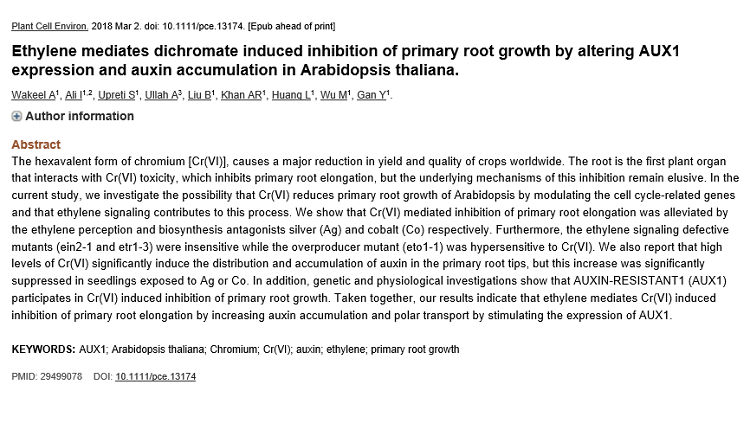On 2nd March, 2018, Professor Gan Yinbo’ lab from the College of Agriculture and Biotechnology, Zhejiang University, published a scientific paper on line on “Plant, Cell & Environment (IF:6.173) “ with the title “Ethylene mediates dichromate induced inhibition of primary root growth by altering AUX1 expression and auxin accumulationin Arabidopsis thaliana (https://www.ncbi.nlm.nih.gov/pubmed/29499078) research paper.
Chromium (Cr) is a heavy metal that has a strong poisoning effect on plant growth. Chromium (Cr) accumulation can cause a series of problems such as reduced seed germination rate, suppressed main root elongation, reduced leaf number, and reduced yield. In addition, chromium (Cr) accumulation in food crops also seriously affects crop yields and Crop food security. Therefore, to study how plants respond to chromium (Cr) accumulation has important theoretical guidance value for agricultural production.
This paper systematically studied how ethylene participates in the regulation of root development in Arabidopsis by affecting auxin signaling pathways. The paper found that chromium mainly inhibited main root elongation by regulating cell cycle-related genes. The paper also found that chromium inhibited the development of major roots by affecting the polar transport of auxin and its distribution at the root tip. More importantly, ethylene and chromium could affect root development by synergistically affecting the expression of the auxin transporter gene AUX1 in the root tip. This is the first report that involved in the regulation of root development by chromium with the interaction of ethylene and auxin signals.
Abdul Wakeel and Imran Ali are Co first authors and Professor Gan Yinbo is the Corresponding author for this paper. The paper was funded by the National Natural Science Foundation of China and the Zhejiang Provincial Natural Science Foundation.
